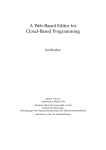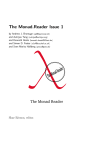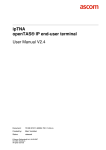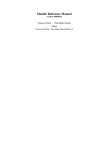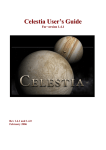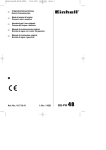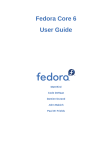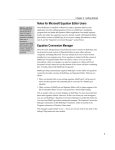Download Leksah: An Integrated Development Environment for Haskell
Transcript
Leksah: An Integrated Development Environment for Haskell Jürgen Nicklisch-Franken Hamish Mackenzie July 21, 2009 Contents 1 Introduction 4 1.1 Further Information . . . . . . . . . . . . . . . . . . . . . . . . . . . . . . 4 1.2 Release Notes . . . . . . . . . . . . . . . . . . . . . . . . . . . . . . . . . . 4 1.2.1 Version 0.6 Beta Release Juli 2009 4 1.2.2 Version 0.4 Beta Release February/March 2009 1.2.3 Version 0.1 Alpha Release February 2008 . . . . . . . . . . . . . . . . . . . . . . . . . . . . . 5 . . . . . . . . . . . . . . 5 2 Installing Leksah 2.1 2.2 2.3 6 Generic Installation Instructions . . . . . . . . . . . . . . . . . . . . . . . 6 2.1.1 Install GHC (Glasgow Haskell Compiler) . . . . . . . . . . . . . . . 6 2.1.2 Install Cabal 6 2.1.3 Install Gtk2Hs . . . . . . . . . . . . . . . . . . . . . . . . . . . . . 6 2.1.4 Install Leksah . . . . . . . . . . . . . . . . . . . . . . . . . . . . . . 7 2.1.5 Where Things Are Installed . . . . . . . . . . . . . . . . . . . . . . 7 2.1.6 Post installation steps . . . . . . . . . . . . . . . . . . . . . . . . . . . . . . . . . . . . . . . . . . . . . . . . . . . . . . . 7 OS X (using MacPorts) . . . . . . . . . . . . . . . . . . . . . . . . . . . . 7 2.2.1 Install MacPorts . . . . . . . . . . . . . . . . . . . . . . . . . . . . 7 2.2.2 Set up ~/.prole . . . . . . . . . . . . . . . . . . . . . . . . . . . . 8 2.2.3 Update MacPorts . . . . . . . . . . . . . . . . . . . . . . . . . . . . 8 2.2.4 Set Variants To Use Quartz (Optional) . . . . . . . . . . . . . . . . 8 2.2.5 Install . . . . . . . . . . . . . . . . . . . . . . . . . . . . . . . . . . 8 2.2.6 Make It Look Nice . . . . . . . . . . . . . . . . . . . . . . . . . . . 8 2.2.7 Point Leksah At The Source . . . . . . . . . . . . . . . . . . . . . . Ubuntu . . . . . . . . . . . . . . . . . . . . . . . . . . . . . . . . . . . . . . . . . . . . . . . . . . . . . . . . . . . . . . . 9 9 2.3.1 Install Prerequisites 2.3.2 Install GHC (Once 6.10.1 is in the universe repository) . . . . . . . 9 2.3.3 Install Cabal 9 . . . . . . . . . . . . . . . . . . . . . . . . . . . . . . 1 9 2.4 2.3.4 Install Gtk2Hs 2.3.5 Add Cabal To Your PATH . . . . . . . . . . . . . . . . . . . . . . . 10 2.3.6 Install Leksah . . . . . . . . . . . . . . . . . . . . . . . . . . . . . . 10 MS Windows . . . . . . . . . . . . . . . . . . . . . . . . . . . . . . . . . . . . . . . . . . . . . . . . . . . . . . . . . . . . . . . 3 First start of Leksah 3.1 10 10 12 Hello World example . . . . . . . . . . . . . . . . . . . . . . . . . . . . . . 4 The Editor 13 16 4.1 Find and Replace . . . . . . . . . . . . . . . . . . . . . . . . . . . . . . . . Grep . . . . . . . . . . . . . . . . . . . . . . . . . . . . . . . . . . . 17 4.2 Source Candy . . . . . . . . . . . . . . . . . . . . . . . . . . . . . . . . . . 18 4.3 Completion 18 4.4 Using the Flipper to Switch Editors . . . . . . . . . . . . . . . . . . . . . . 19 4.5 Editor Preferences . . . . . . . . . . . . . . . . . . . . . . . . . . . . . . . 19 4.6 Further info . . . . . . . . . . . . . . . . . . . . . . . . . . . . . . . . . . . 20 4.1.1 . . . . . . . . . . . . . . . . . . . . . . . . . . . . . . . . . . . 5 Packages 16 21 5.1 Package Editor . . . . . . . . . . . . . . . . . . . . . . . . . . . . . . . . . 21 5.2 Building . . . . . . . . . . . . . . . . . . . . . . . . . . . . . . . . . . . . . 22 5.3 Background Build . . . . . . . . . . . . . . . . . . . . . . . . . . . . . . . 23 5.4 Build system ags . . . . . . . . . . . . . . . . . . . . . . . . . . . . . . . 24 5.5 Import Helper . . . . . . . . . . . . . . . . . . . . . . . . . . . . . . . . . . 24 6 Module Browser and Metadata 26 6.1 The Modules Pane . . . . . . . . . . . . . . . . . . . . . . . . . . . . . . . 26 6.2 The Info Pane . . . . . . . . . . . . . . . . . . . . . . . . . . . . . . . . . . 28 6.3 The Search Pane . . . . . . . . . . . . . . . . . . . . . . . . . . . . . . . . 29 6.4 The References Pane . . . . . . . . . . . . . . . . . . . . . . . . . . . . . . 30 6.5 Metadata collection . . . . . . . . . . . . . . . . . . . . . . . . . . . . . . . 30 7 Debugger 32 8 Conguration 34 8.1 Layout . . . . . . . . . . . . . . . . . . . . . . . . . . . . . . . . . . . . . . 8.1.1 Group panes 8.1.2 Detached windows . . . . . . . . . . . . . . . . . . . . . . . . . . . . . . 34 34 . . . . . . . . . . . . . . . . . . . . . . . . . . . 35 . . . . . . . . . . . . . . . . . . . . . . . . . . . . . . . . 35 . . . . . . . . . . . . . . . . . . . . . . . . . . . . . . . . . . . . 36 8.2 Session handling 8.3 Shortcuts 8.4 Conguration les . . . . . . . . . . . . . . . . . . . . . . . . . . . . . . . 9 The Project 38 10 Appendix 10.1 Command line arguments 36 39 . . . . . . . . . . . . . . . . . . . . . . . . . . . 2 39 10.2 The Candy le . . . . . . . . . . . . . . . . . . . . . . . . . . . . . . . . . 39 . . . . . . . . . . . . . . . . . . . . . . . . . . . . . . . . 40 . . . . . . . . . . . . . . . . . . . . . . . . . . . . . . . . 12 10.3 The Keymap le List of Figures 1 FirstStart dialog 2 After start . . . . . . . . . . . . . . . . . . . . . . . . . . . . . . . . . . . . 13 3 Leksah with open project . . . . . . . . . . . . . . . . . . . . . . . . . . . 14 4 File menu . . . . . . . . . . . . . . . . . . . . . . . . . . . . . . . . . . . . 16 5 Edit menu . . . . . . . . . . . . . . . . . . . . . . . . . . . . . . . . . . . . 16 6 Find bar . . . . . . . . . . . . . . . . . . . . . . . . . . . . . . . . . . . . . 17 7 Grep pane . . . . . . . . . . . . . . . . . . . . . . . . . . . . . . . . . . . . 17 8 Source candy example . . . . . . . . . . . . . . . . . . . . . . . . . . . . . 18 9 Completion . . . . . . . . . . . . . . . . . . . . . . . . . . . . . . . . . . . 19 10 Editor Preferences . . . . . . . . . . . . . . . . . . . . . . . . . . . . . . . 19 11 Package Menu . . . . . . . . . . . . . . . . . . . . . . . . . . . . . . . . . . 21 12 PackageEditor 1 . . . . . . . . . . . . . . . . . . . . . . . . . . . . . . . . . 22 13 Error Pane . . . . . . . . . . . . . . . . . . . . . . . . . . . . . . . . . . . 23 14 Package Flags . . . . . . . . . . . . . . . . . . . . . . . . . . . . . . . . . . 24 15 Import dialog . . . . . . . . . . . . . . . . . . . . . . . . . . . . . . . . . . 25 16 Modules pane . . . . . . . . . . . . . . . . . . . . . . . . . . . . . . . . . . 27 17 Construct module dialog . . . . . . . . . . . . . . . . . . . . . . . . . . . . 28 18 Info pane . . . . . . . . . . . . . . . . . . . . . . . . . . . . . . . . . . . . 28 19 Search pane . . . . . . . . . . . . . . . . . . . . . . . . . . . . . . . . . . . 29 20 References Pane . . . . . . . . . . . . . . . . . . . . . . . . . . . . . . . . . 30 21 Metadata menu . . . . . . . . . . . . . . . . . . . . . . . . . . . . . . . . . 30 22 Metadata Preferences . . . . . . . . . . . . . . . . . . . . . . . . . . . . . . 31 23 Debug & Buer menu . . . . . . . . . . . . . . . . . . . . . . . . . . . . . 32 24 Debug Pane . . . . . . . . . . . . . . . . . . . . . . . . . . . . . . . . . . . 33 25 View menu 26 Initial pane position 27 Session menu . . . . . . . . . . . . . . . . . . . . . . . . . . . . . . . . . . . 34 . . . . . . . . . . . . . . . . . . . . . . . . . . . . . . 35 . . . . . . . . . . . . . . . . . . . . . . . . . . . . . . . . . . 36 License Leksah has been put under the GNU GENERAL PUBLIC LICENSE Version 2. The full license text can be found in the le data/gpl.TX in the distribution. 3 1 Introduction Leksah is an IDE (Integrated Development Environment) for the programming language Haskell. It is written in Haskell. Leksah is intended as a practical tool to support the Haskell development process. Leksah uses GTK+ as GUI Toolkit with the gtk2hs binding. It is platform independent and should run on any platform where GTK+, gtk2hs and GHC can be installed. is tested on Linux, Windows and Mac. It It uses the Cabal package management and build system for Package Management. It needs the Glasgow Haskell Compiler for full functionality (GHC). This document is a reference to the functionality of Leksah, it is not intended to be a tutorial. Since Leksah is in the state of development the information may be incomplete or even wrong. 1.1 Further Information The home page for Leksah is leksah.org. The source code for Leksah is hosted under code.haskell.org/leksah. The Leksah user Wiki is haskell.org/haskellwiki/Leksah. The Leksah mailing list can be accessed at projects.haskell.org/cgi-bin/mailman/listinfo/leksah. The current version of this manual can be found at leksah.org/leksah_manual.pdf. An issue tracker is at code.google.com/p/leksah/issues/list. You can contact the developers at info (at) leksah.org. For the Programming language Haskell go to www.haskell.org. For information about gtk2hs www.haskell.org/gtk2hs/. For information about GTK+ go to www.gtk.org. 1.2 Release Notes 1.2.1 Version 0.6 Beta Release Juli 2009 The 0.6 version introduces an interpreter/debugger mode. This mode can be switched on and o from the toolbar. In interpreter/debugger mode expressions can be evaluated and the type of expressions can be dynamically shown. The GHCi debugger is integrated, so that breakpoints can be set, it is possible to step through the code, observe the values of variables and trace the execution history. The other features of Leksah like building in the background and reporting errors on the y work in debugger mode as in compiler mode. Another new feature is integration of grep and text search with regular expression. This can be accessed from the ndbar. The GUI framework has been enhanced, so that layouts can be nested in so called group panes. This feature is used for the debugger pane. Furthermore notebooks can be detached, so that Leksah can be used on multiple screens. A lot of little enhancements has been made and numerous bugs has been xed. Known bugs and problems: • The package editor works only for cabal les without congurations. 4 • MS Windows: The check for external modications of source les does not work. • MS Windows: Interruption of a background build does not work. • GUI History still not working. • Traces pane of the Debugger does not work appropriately. 1.2.2 Version 0.4 Beta Release February/March 2009 The 0.4 Release is the rst beta release of Leksah. It should be usable for practical work for the ones that wants to engage with it. It depends on GHC ≥6.10.1 and gtk2hs ≥ 0.10.0. The class pane and the history feature are not quite ready, so we propose not to use it yet. 1.2.3 Version 0.1 Alpha Release February 2008 This is a pre-release of Leksah. The editor for Cabal Files is not ready, so we propose not to use it yet. w 5 2 Installing Leksah It is a good idea to install sources for your Haskell libraries when using Leksah. Leksah can then give you much better information from Metadata. Installing with cabal install will do that, and you can download the sources for GHC even after you installed it from a binary package. However compiling from sources is necessary for special packages, which perform some special magic, like generating header les or such. With sources installed Leksah will show you source comments for functions while auto-completing and will be navigate you to the sources of functions. If you have any trouble installing and this manual will not help, please check the Wiki, the mailing list or contact the developers to nd a solution. If it is a Leksah problem, then it is important to us and needs to be xed. We work on installers for Windows and Mac and packages for Debian/Ubuntu are in preparation. Further help needed! 2.1 Generic Installation Instructions 2.1.1 Install GHC (Glasgow Haskell Compiler) At the time of writing Leksah supports GHC in the versions (6.10.*). For information about installing GHC go to http://haskell.org/ghc. 2.1.2 Install Cabal At the time of writing Leksah requires at least version 1.6.0.1. For information about installing Gtk2Hs got to http://haskell.org/cabal. On operating systems with package managers you may nd that a Cabal package is available. Once again if you want good Metadata for the Cabal functions, try to build binaries on your machine. 2.1.3 Install Gtk2Hs At the time of writing Leksah supports only the most current version (0.10.*). information about installing Gtk2Hs got to For http://haskell.org/gtk2hs. If you are planning on installing a newer version, then you will need to make sure it is compatible with the version of GHC you have installed rst. On operating systems with a package manager you may wish to use a source OS package and build a binary OS package to install. You should be able to prevent the working directory from being cleaned, so it can be used for Leksah's Metadata. Doing this means that other OS packages depending on Gtk2Hs can still easily be installed. If you compile Gtk2Hs manually, check the output of ./congure. At the end it will list the Haskell packages that are going to be build. Leksah needs GTK, glib and gtksourceview2. Gtk2Hs conditionally compiles some code dependent of the version of the underlying GTK libraries. This can cause strange compiler errors when compiling Leksah later. 6 2.1.4 Install Leksah Either: Install cabal-install from http://haskell.org/cabal. Then run cabal install leksah user. This is the preferred way. Or: Download, congure, build and install the prerequisite packages: binary bytestring ≥0.9.0.1, utf8-string ≥0.3.1.1, regex-posix ≥0.39.1 which hackage.haskell.org with typical Cabal procedure. (Go HackageDB of the package. Then do ≥0.4.1, is available from to the root folder runhaskell congure, runhaskell build, sudo runhaskell install. The other packages needed should have been installed with GHC anyway. (I'm nut sure if GHC-extralibs is needed). Then get the Leksah package via Hackage and do the same. 2.1.5 Where Things Are Installed Leksah installs a an executable in a folder that should be in the search path, and a couple of data les in a data folder. These places are chosen by the Cabal package management system and depend on the target platform and the way you install. On Linux the data folder may be /usr/share/leksah-0.4/data. For storing preferences, sessions and collected meta-data Leksah constructs a .leksah directory in your home folder. If you want to change or add conguration les for keymaps, source candy, etc, you can put them in this place. 2.1.6 Post installation steps If you upgrade to version 0.6 you should clean the Current.session and maybe the De- fault.prefs le from your .leksah conguration folder. This means that you loose your personal settings. As well you should clean the IDE.session les from the project folders you are working on (or at least avoid to open them when prompted). If you use a customized keymap in your .leksah folder, you need to append new keybindings. New With version 0.6 for a pleasant visual appearance, you have to copy or append the .gtkrc-2.0 le from the Leksah data folder or from the data folder in Leksah sources to your home folder. 2.2 OS X (using MacPorts) We have just nished building an Intel Mac dmg and we would like to know if it works ok. If you have a chance, could you install it and let us know if it runs ok. http://leksah.org/Leksah.dmg Before starting with the installer, this is our recommended procedure for installing on OS X at present. 2.2.1 Install MacPorts Download and install MacPorts by following the instructions on org/install.php. 7 http://www.macports. 2.2.2 Set up ~/.prole Add the following to your ~/.prole then open a new terminal window and type set to make sure it has worked export PATH=~/.cabal/bin:/opt/local/bin:$PATH export XDG_DATA_DIRS=/opt/local/share XDG_DATA_DIRS is only needed at run time, so if you have already built without it you can just add it now and it should help GTK nd the les it needs. 2.2.3 Update MacPorts Run sudo port selfupdate. To make sure you have the latest Portles. 2.2.4 Set Variants To Use Quartz (Optional) If you want to use the Quartz version of GTK+ (instead of the X11 version) then add the following to /opt/local/etc/macports/variants.conf. +no_x11 -x11 +quartz Warning 1 doing this will disable OpenGL support in GTK+ or Gtk2Hs (gtkglext). Warning 2 for some reason GTK applications when they start will not be in the foreground, instead they will be hidden all your other running applications. Warning 3 if you already have GTK MacPorts packages installed then you need to uninstall and reinstall the packages that support these variants 2.2.5 Install Run the following to install leksah. The -k is important it keeps the source and .hi les for use in the Leksah metadata. Do not include gtkglext in the rst line if you are building the Quartz version (as it is only supported in X11 builds). sudo port install gtk2 cairo librsvg libglade2 gtksourceview2 gtk-chtheme gtk2-clearlooks gtkglext pkg-config --modversion gtksourceview-2.0 The pkg-config should output version 2.4.2 or greater. If it does not check your PATH has /op/local/bin before any other folders with pkg-config. Once this is sorted you can move on to running... sudo port -k install ghc gtk2hs hs-cabal cabal install leksah If you have errors at this point it is a good idea to check ghc-pkg 2.2.6 Make It Look Nice Run gtk-chtheme and choose one of the Clearlooks themes. 8 list 2.2.7 Point Leksah At The Source Run leksah and when it asks for paths under which haskell source packages may be found add the following to the list. /opt/local/var/macports/build/_opt_local_var_macports_sources_rsync.macports.org_release_ports_lang_ghc/work/ghc-6.10 /opt/local/var/macports/build/_opt_local_var_macports_sources_rsync.macports.org_release_ports_devel_gtk2hs/work/gtk2 2.3 Ubuntu 2.3.1 Install Prerequisites Open up the package manager and make shure the following packages are installed: • glib-devel • gtksourceview2-devel • make • gcc • g++ • libgmp3-dev 2.3.2 Install GHC (Once 6.10.1 is in the universe repository) At the time of writing only 6.8.2 was available in the Ubuntu universe repository. If you have ghc 6.8 installed then we recomend you uninstall it to avoid conicts. sudo apt-get remove ghc6 sudo apt-get build-dep ghc6 wget http://www.haskell.org/ghc/dist/6.10.1/ghc-6.10.*-src.tar.bz2 wget http://www.haskell.org/ghc/dist/6.10.1/ghc-6.10.*-src-extralibs.tar.bz2 tar xjf ghc-6.10.1-src.tar.bz2 tar xjf ghc-6.10.1-src-extralibs.tar.bz2 cd ghc-6.10.1 ./configure --prefix=/home/username/ghc make make install export $PATH=$PATH:/home/username/ghc/bin 2.3.3 Install Cabal wget http://www.haskell.org/cabal/release/cabal-install-0.6.2/cabal-install-0.6.2.tar.gz tar -xvjpf cabal-install-0.6.2.tar.gz cd cabal-install-0.6.2 ./bootstrap 9 2.3.4 Install Gtk2Hs Check the output of ./congure, at the end it should list the haskell packages it is going to build. Leksah needs gtksourcevie, gtk and glib (if you have installed glib-devel and gtksourceview2-devel then these should be enabled). If there are any that are not going to be installed that you would like, then you most likely need to install the corresponding -devel ubuntu package. wget http://downloads.sourceforge.net/gtk2hs/gtk2hs-0.10.0.tar.gz tar -xvjpf gtk2hs-0.10.0.tar.gz cd gtk2hs-0.10.0.tar.gz ./configure make sudo make install 2.3.5 Add Cabal To Your PATH Cabal can install packages globally or local to the current user (use user and global to select which). We recommend you add the following to your ~/.bash_prole PATH=$PATH:/home/sean/.cabal/bin export PATH If you change your path you will have to restart X to make it apply automatically or you can type source ~/.bash_profile each time you open a new terminal until you get a chance to restart X. 2.3.6 Install Leksah cabal update cabal install leksah 2.4 MS Windows In the future I hope we can provide a Windows installer. For now the situation is dicult, because the latest gtk2hs Windows installer that works for Leksah is 0.10.0, which only works with GHC 6.10.2. GTKSourceView2 component. Build 0.10.1 of gtk2hs has an issue with the the A windows installer for GHC 6.10.4 is missing. Please write to the gtk2hs users mailing list if you want this situation to improve. This is what you can do to get leksah running on Vista: 1. Install Cygwin with the online installer from http://www.cygwin.com/ Select packages wget, curl and gcc-core in adition to the standard selection. I used the 1.7.0 version of Cygwin setup, but it is still beta. 2. Install your GHC from http://www.haskell.org/ghc. 3. Install gtk2hs from http://www.haskell.org/gtk2hs/ or Sourceforge.net. 10 4. Download the GHC sources from http://www.haskell.org/ghc. Open a Cygwin shell, make a directory Haskell, copy the source tarballs here and unpack them. Take care that the directory name has no blanks in its path! 5. cabal install leksah. (Guess it is already installed with 6.10.2?) 6. You may wish to install a full Unicode monospace font if you want to use the source candy feature of leksah. e.g. Everson Mono or Deja Vu Sans Mono or perhaps the GNU FreeFonts which are aesthetically pleasing. 7. Start leksah and give your Haskell directory as source root. Select the right font from Help/Prefs. 8. Have fun with leksah, but remember it is a beta version! 11 Figure 1: FirstStart dialog 3 First start of Leksah 1. When you start Leksah for the rst time, the rst start dialog appears (1). You have to specify folders, under which Haskell source code for installed packages can be found. This can be any folder above the source directories. So gure out what this will be on your system. You have to click the Add Button after selecting the folder. 2. If you use cabal install add the cabal install package directory to the extract packages from cabal-install section. This means that leksah decompresses and untars the sources, so they can be scanned by Leksah. This is kind of a hack currently. Later you can change this settings in the preferences pane in Leksah and you can rebuild the metadata at any time. Details about metadata collection can be found here: 6.5. If you want to start from scratch again delete or rename the .leksah folder in your home folder. Then you will see the rst start dialog again. 1. Now Leksah collects information about all installed packages on your system. So it may take some time, but at further starts only information for new packages will be installed. Their will eventually be a bunch of errors on your command line, but don't worry, it only means that Leksah has not succeeded to extract the source locations and comments for certain modules or packages. 2. After starting up, Leksah will open its Main window in a standard conguration (2). 12 Figure 2: After start 3. One way to start up, and probably the best way if you already have experience with Haskell, will be to open an existing project. So select Package/OpenPackage from the menu and open a Cabal le of some project. A typical Leksah window may then look like 3. Alternatively you can start with a 3.1 Hello World example Create a Package with one Executable (name of both can be the same) • Package -> New and use the "Create Folder" button to make a new folder for the package. Fill in your package identier including a version number. • Click on the Dependencies tab (in the package editor). Type in "base" and click "Add" (this is like the references in visual studio projects) • Click on the Executables tab (in the package editor). Fill in an executable name and put Main.hs in the le with main function and click "Add". • Click on Build 1 Build Info . Add src to the list. should all end up in the src sub directory. 13 This way your source les Figure 3: Leksah with open project • Click Save and Close Add the Main module • Click on the Modules tab (this is like the class browser in visual studio). click and select Add Module. Put Main in the New Module box. • Add main = putStrLn "Hello World" Run it • Package -> Congure • Package -> Build • Package -> Run • Output will be in the Log window Debug it • • Switch debugger Mode on. Debug -> Show Debugger 14 Right • Select the word main in your code • Right click and choose Eval It is probably counter productive for new users to use Candy mode (converts some common ascii based operators to Unicode alternatives) because all the tutorials use ascii. Switch it o when you get irritated. For a further info refer to: http://en.wikibooks.org/wiki/Haskell. 15 4 The Editor The central functionality needed for development is to edit Haskell source les. Leksah uses the GtkSourceView2 widget for this. It provides editing, undo/redo, syntax highlighting and other features. In the le menu (4) you have the usual functionality to open, save, close and revert les. You can as well close all les, and all les which are not stored in or below the top folder of the current project (this is the folder where the .cabal le resides). Leksah does not store backup les. Leksah detects if a le has changed which is currently edited and queries the user if a reload is desired. When you open a le which is already open, leksah queries if you want Figure 4: File menu to make the currently open le active, instead of opening it a second time (Leksah does not support multiple views on a le, but if you open a le a second time, it's like editing the le two times, which makes little sense). When a le has changed compared to the stored version, the le name is shown in red in the notebook tab. If you want to change to a dierent buer you can open a list of all open buers by pressing the right mouse button, while the mouse is over a notebook tab. You can then select an entry in this list to select this le. (See 4.4 for a better way to switch between source les. On the right side in the status bar you can see the line and column, in which the cursor currently is; and if overwrite mode is switched on. In the second compartment from the left you can see the currently active pane, which is helpful if you want to be sure that you have selected the right pane for some operation. In the edit menu (5) you nd the usual operations: undo, redo, cut, copy, paste and select all. In addition you can comment and un-comment selected lines in a per line style (). Furthermore you can align some special characters (=,<,->,::,|) in selected lines. The characters are never moved to the left, but the operation is very simple and takes the rightmost position of the special character in all lines, and inserts spaces before the rst occurrence of this special characters in the other lines for alignment. 4.1 Find and Replace Leksah supports searching in text les. When you select Edit/Find from the menu the nd bar will open (6) and you can type in a text string. Alternatively you can hit Ctrl-F or select a text and hit Ctrl-F (This is a standard keystrokes. Keystrokes can be congures, see 8.3). Hitting the up and down arrow will bring you to the next/previous occurrence 16 Figure 5: Edit menu Figure 6: Find bar Figure 7: Grep pane of the search string. Hitting Enter has a similar eect as the down arrow. Hitting Escape will closes the nd bar and sets the cursor to the current nd position. You have options for case sensitive search(c.S.), for searching only whole worlds (Words) and for wrapping around (Wrap), which means that the search will start at the beginning/end of the le, when the end/beginning is reached. If their is no occurrence of the search string the entry turns red. You can search for regular expressions by switching on the Regex option. Leksah supports regular expressions in the Posix style (by using the regex-posix package). When the syntax of regular expressions is not legal, the background of the nd pane turns orange. To replace a text enter the new text in the replace entry and select replace or replace all. The nd bar supports as well to jump to a certain line number in the current text buer. 4.1.1 Grep For this feature the grep program must be on your path. You can then enter a search string in the nd bar and hit the Grep button. This will search for all occurrences for the string in the folder and subfolder of the current package. Greps supports the search for regular expressions. A pane will open (7), and in every displayed line the expression was found. By clicking on the line, an editor is opened or brought to front and the focus is set to the selected line. You can navigate between lines with the up and down keys. 17 4.2 Source Candy Figure 8: Source candy example When using Source Candy, Leksah reads and writes pure ASCII Code les, but can nevertheless show you nice symbols like λ.This is done by replacing certain character combinations by a Unicode character when loading a le or when typing, and replace it back when the le is saved. The use of the candy feature can be switched on and o in the menu and the preferences dialog. This feature can be congured by editing a .candy le in the .leksah folder or in the data folder. The name of the candy le to be used can be specied in the Preferences dialog. Lines in the *.candy le looks like: "\" 0x03bb --GREEK SMALL LETTER LAMBDA "->" 0x2192 Trimming --RIGHTWARDS ARROW The rst entry in a line are the characters to replace. The second entry is the hexadecimal representation of the Unicode character to replace with. The third entry is an optional argument, which species, that the replacement should add and remove blanks to keep the number of characters. This is important because of the layout feature of Haskell. The last entry in the line is an optional comment, which is by convention the name of the Unicode character. Using the source candy feature can give you problems with layout, because the alignment of characters with and without source candy may dier! Leksah reads and writes les encoded in UTF-8. So you can edit Unicode Haskell source les. When you want to do this, switch of source candy, because otherwise Unicode characters may be converted to ASCII when saving the le. 4.3 Completion Leksah has the ability to auto complete identiers in text you type. Additionally the Package, Module and Type of the id gets displayed if selected. This completion mode can either be always on, or only be activated on pressing Ctrl+Space (or a user dened keystroke). You can choose between these two possibilities in the Preferences. Leksah currently uses all names provided by the package scope for completion. So it has no context sensitiveness, and doesn't provide locally dened names. 18 Figure 9: Completion 4.4 Using the Flipper to Switch Editors You can change the active pane using a keyboard shortcut to bring up the ipper. It lists the most recently used panes rst so they are easier to get to. The default shortcuts for the ipper are Ctrl+Tab and Ctrl+Shift+Tab or Ctrl+Page Down and Ctrl+Page Up. 4.5 Editor Preferences Figure 10: Editor Preferences When selecting Conguration / Edit Prefs the preferences pane opens, which has a selection called Editor (Figure 8), were you can edit preferences for the editor. Some of the options you nd here refer to visual elements, like the display of line numbers, the font used, the display of a right margin and the use of a style le for colors and syntax highlighting. You can set here the Tab size you want. Leksah always stores tabs as spaces to ease the use of layout. (As you may know, otherwise only a tab size of 8 can be digested by 19 Haskell compilers). 1 Leksah oers as well to remove trailing blanks in lines, which you may choose as default, because blanks at the end of lines make no sense in source code. 4.6 Further info The work with the editor is inuenced by other features • For background building, which may save your les automatically after every change refer to 5.3. • 1 For information about editor preferences go to 4.5. Leksah has an option for storing the les with standard UNIX line ends even on Windows, and not using the infamous Cr/Lf combination. This is e.g. useful if Windows and other users commit to the same repository. This may not work anymore since switching to unicode sources? 20 5 Packages Leksah does not only support editing Haskell source les, but as well building the application or program you are developing. The concept of a package is used to handle a unit of work for the development of some library or executable. One instance of Leksah can only open one package at a time. (It is a wish of many users to make this more exible in the way of e.g. Eclipse Workspaces). Leksah can store congurations for packages separately (and does this by default), so that you can switch between packages and get exactly back to where you stopped when opening a dierent package. Leksah uses Cabal for package management, and opening a package is done by opening a .cabal le. So when you select Package / Open Package from the menu, select the *.cabal le of the desired package. Leksah shows the currently active package in the third compartment in the status bar. To start with a new package select Package / NewPackage from the menu. Then you have to select a folder for the project, this is by convention the same name you will give to your package. Then the package editor will open up, in which you have to supply information about your package. Figure 11: Package Menu 5.1 Package Editor The package editor (12) is an editor for cabal les. Since cabal les oer complex options the editor is quite complex. For a complete description of all options see the Cabal User's Guide. editor does currently not support the cabal congurations feature. The package If you need cabal congurations, you need to edit the cabal les as a text le. Since Leksah uses standard cabal les with no modications this is no problem, and you can use Leksah with such packages with no problem, just the package editor will not work for you. (We plan to enhance the editor to support congurations in the future). The minimum requirements for any package is to give a name and a version. Then you will have to enter dependencies on other packages in the dependencies part of the editor. This will be at least the base package. Finally you have to specify an executable or a library that should be the result of your coding eort. You do this in the Executable and Library part of the editor. Cabal gives the possibility to build more then one executable from one package and to build a library and executables from one package. For an executable you enter a name, the source le with the main function and a build info. For a library you enter the exposed modules and a build info. With build information you give additional information, e.g: 21 Figure 12: PackageEditor 1 • where the sources can be found (relative to the root folder of the project, which is the one with the cabal le). • what additional non-exposed or non main modules your project includes • compiler ags • used language extensions in addition to Haskell 98 (These can also be specied in the source les with pragmas) • and many more ... Because more then one executable and a library can be build from one package, it is possible to have cabal les with more then one build info. The package editor deals with this by the buttons Add / Remove Build Info. Every build info gets an index number, and for executables and a library you specify the index of the build info. 5.2 Building The most frequently used functionality with packages is to make a build, which is possible after a successful congure. When you start a build, you can see the standard output of the Cabal build procedure in the Log pane. A build may produce errors and warnings. If this is the case the focus is set to the rst error/warning in the Log and the corresponding source le will open with the focus at 22 Figure 13: Error Pane the point where the compiler reports the error. You can navigate to the next or previous errors by clicking on the error or warning in the log window, or by using the menu, the toolbar or a keystroke. In the statusbar the state regarding to the build is displayed in the third compartment from the right. It reads Building as long as a build is on the way and displays the numbers of errors and warnings after a build. This is the symbol, which initiates a build when clicked on the toolbar (Ctrl-b). The error pane (13) shows the errors in the form of a table and provides the same functionality you nd in the log, but it may be more convenient to use. 5.3 Background Build Leksah can run builds while you work and highlight errors as it nds them. This works with a timer that runs continuously in the background. If there are changes made to any open le it . . . • interrupts any running build by sending SIGINT (sadly this step is OSX and Linux only at this point) • waits for any running build processes to nish • saves all the modied les • starts a new build Because we can't interrupt the build on windows there is an option in the Leksah build preferences to have it skip the linking stage in background builds. This reduces the delay before a next build starts. Background build and linking can be congured in the preferences and as well switched on and o from the toolbar. 23 Figure 14: Package Flags This is the symbol, which switches background build on or o in the toolbar. Linking with background build on or o. 5.4 Build system ags As you can see in the package menu (11) you can do more operations with packages, which are mostly provided by the Cabal system. You can clean, congure, build and if you have build an executable run your program. And other operations like building a source distribution and building haddock documentation. For more details about these operations (as said before) consult the Cabal User's Guide. Since many of these operations can take additional ags you can enter these by selecting Package / Edit ags. Then the Flags pane opens up (Figure 12). For example haddock documentation for the leksah source will not be build, because it is not a library unless you pass the executable ag. The ags are stored in a le called IDE.ags in the root folder of the project. If you want to link with the locally installed libraries (ghc-pkg) Haskell packages locally, set: cong ags user 5.5 Import Helper A frequent and annoying error is the Not in scope compiler error. In the majority of cases it means that an import statement is missing and to write import statements is a frequent and annoying task. In Leksah if you need to add an import, you can choose 24 Add Figure 15: Import dialog import from the context menu in the log pane. Leksah will then add an import statement to the import list. If their is more then one module that exports this identier, a dialog will appear which queries you about the module you want to import from (15). Leksah then adds a line or an entry to the import list of the aected module with the compiler error. It adds as well an entry in the lop pane. Leksah imports individual elements, but imports all elements of a class or data structure if one of them is needed. The import helper can work with qualied identiers and will add a correct import statement. You can as well select all Not in scope add all imports from the context menu, in which case errors will be treated sequentially. When Leksah does not nd an identier update the Leksah database. Update Metadata The import helper just looks in imported packages, so if you miss a package import, you have to x it manually. Obviously some not in scope errors have other reasons, e.g. you have misspelled some identier, which can't be resolved by adding imports. 25 6 Module Browser and Metadata Leksah collects data about the exported modules of all installed Haskell packages on your system. It does this by reading the Haskell interface les (from GHC). In addition it adds source positions and comments of packages, for which a cabal le with the corresponding source les can be found. The package you work on is treated dierently, as not only external exported entities are collected, but all exports from all modules are collected. This makes it possible to get information about identiers: sort symbol function data constructor slot type • Which packages and modules export this identier? newtype • What is the sort of the exported identier? class member If the source was found: • What is the comment for this identier? • Where is the source with position? instance rule If you like to get information about some identier in the code, the easiest way is to press Ctrl and double click Table 1: Sorts of identi- ers on it. More precisely the operation is not triggered by the double click operation, but by the release of the left button. So if the double click does not select the right area for a special id like ++, you can select the desired characters with the left button and then release it while you hold down the Ctrl key. If the id is known unambiguously the modules and info pane will show information about it. If more then one possibility exist the search pane will open and present the alternatives. The current Leksah metadata does not contain denitions local to a module. So names which are not exported will not be found in the metadata. We plan to change this for the current project for future versions. 2 You can see the sort of expression by the icon before the identier. The following sorts of identiers are currently known in the Metadata: 6.1 The Modules Pane In the modules pane (16) you get information about modules and their interface. The displayed information depends on the open package. If no package is open only the system scope has information. (If a package is open, it's name is displayed in the third subdivision from the left of the status bar.) 2 We started with the global approach from the intuition, that it takes most of our time to nd something that is not already imported and known. A local denition can be easily nd by a text search. 26 Figure 16: Modules pane We assume there is an open package. You can then select the scope of the displayed information with the radio button on top of the modules pane. The only modules which are part of the current project. The Local scope shows Package scope shows all modules System scope of the package and all packages which the current package depends on. The shows all modules of installed packages of the system. (You can get the list of all installed packages with ghc-pkg list. Leksah scans the user and the system package database, when both are present). If the Blacklist toggle button is selected, the packages in the blacklist are not displayed. The information is accessible, but the modules are excluded from the modules browser. 3 . The Blacklist can be edited in the preferences pane. If you select a module in the modules list, its interface is displa yed in the interface list on the right. You can search for a module or package by selecting the modules list and typing some text. With the up and down arrows you nd the next/previous matching item. With the escape key or by selecting any other GUI element you leave the search mode. If this icon shows up, Leksah has found a source le or source position for this element. You can open the source le, or bring it to the front and display the source for the selected location with a selecting Go to denition double click on the element. (the same can be done with from the context menu. This is reexported from another module. 3 I invented the blacklist mainly for the GHC package, when will they use hierarchical module names? 27 By selecting an element in the Interface List the so called Info Pane is shown with additional information. The quickest way to edit some project le is to go to the modules pane, select local scope and nd the module by entering text, and double click for editing the le. Figure 17: Construct module dialog The easiest way to add a new module is by selecting Add module from the context menu of the modules pane. The Construct Module dialog will open (17). You have to enter the name of the module, the source path to use if alternatives exist and, when the project is a library, if the module is exposed. Leksah will construct the directory, modify the cabal le and construct an empty module le from a template. The modication of the cabal le will currently only happen, if it does not contain congurations. 6.2 The Info Pane The Info Pane (18) shows information about an interface element, which may be a function, a class, a data denition, a type . . . . It shows the identier, the package and module that it is exported by, it's Haskell type and if found a comment. If you select initiate an identier search in an editor, and information about this identier is available in the package scope, it is automatically displayed in the info pane. Again, the easiest way to do this is to double click on an identier while pressing Ctrl. Remember that only statically collected information is available this way, and only about items which are exported by some module. Figure 18: Info pane 28 Figure 19: Search pane If a source location is attached, you can go to the denition by clicking the Source button. You can select the module and the interface element in the modules pane by clicking the Modules button. Refs button a pane opens which displays modules which uses this element. With the Docu button you can initiate an external search in a browser with e.g. hayoo With the or Hoogle, depending on the conguration in the Preferences. With the Search button you can initiate a metadata search for the identier. 6.3 The Search Pane You can search for an identier in the metadata by typing in characters in the entry at the bottom of the pane. The search result depends on the settings in the search pane (19). You can choose: 1. The scope in which to search, which can be local, package or system. 2. The way the search is executed, which can be exact, prex or as a regular expression. 3. You can choose if the search shall be case sensitive or not. The result of the search is displayed in the list part of the Search pane. You can see if the module reexports the identier, or if the source of the identier is reachable. When you single click on a search result, the info pane shows the corresponding information. If you double click on an entry, the modules and info pane shows the corresponding information. If you double click on an identier and press Ctrl in a source buer, it is a case sensitive and exact search in the package scope. It does not depend on the selection in the search pane. 29 Figure 20: References Pane 6.4 The References Pane As said in the end of the last section, this pane shows which modules uses a certain element. The element is displayed in the top, and the modules which import it are displayed in the list box. If you double click on an entry in the list box, the corresponding source will be opened if possible. Then a text search on the selected element is initiated. 6.5 Metadata collection Metadata collection depends on the conguration and can be manually triggered. If you select Metadata / Update Project the metadata for the current project is collected from the .hi les and the source les. You should select this if the metadata of the current project is out of sync. If you select Metadata / Update Lib Leksah checks if a new library has installed and if this is the case collects metaFigure 21: Metadata data for it. In the Metadata part of the preferences (22) you can edit menu the settings concerning metadata collection. Metadata collection is a dicult point, because it depends on the installation, environment, the installed packages, etc. However, to make good use of leksah it is highly desirable to have metadata with sources available for the packages you really need. So here we explain how metadata collection works: 1. Since cabal install has sources only as compressed tar archives on your machine, leksah needs to unpack this. You can see if this works by browsing the folders. You can initiate this step by calling leksah -x - n. If only root has write access to some cabal packages do a: sudo leksah -x -n (Extract NoGui). 2. Now leksah looks for all cabal les it can nd below the source folders. From this information the le source_packages.txt in the .leksah folder is written. If you miss sources for a package in Leksah, consult this le if the source place of the 30 Figure 22: Metadata Preferences package has been correctly found. You can run this step by: leksah -s -n (Sources NoGui). 3. The metadata collection itself proceeds in two steps: A) Extract info from .hi les, which is usually no problem. B) Add source locations and comments by parsing the sources. This can be a problem because of preprocessing, header les, language extensions, etc. The result is stored in a folder under the .leksah folder (under your home folder). The folder will be named after the compiler version (e.g. ghc-6.8.1). In this folder for every package a metadata le is stored (e.g. binary-0.4.1.pack). These les are in binary format. You can rebuild the whole metadata when you start Leksah with the -r -n option (Rebuild NoGui). You can update the metadata with: leksah -c -n (Collect NoGui) If you have a problem with a certain package, remove its metadata le , e.g. rm ~/.leksah/ghc-.../binary*. And then do a collect: leksah -c -n. Look for error messages in the Console to see if some problem is reported. 4. For the current package a slightly dierent procedure is used, because leksah not only looks for exported library entities, but for all exports of every module. The written metadata le has the extension .packw. 31 7 Debugger You can switch Debugger mode on from the toolbar: Switch debugger Mode on or o. After switching debugger mode on, you can see that packages and modules for your current project are loaded into GHCi. When debugger mode is on, you see that the menu entries from the Debug menu are no longer disabled, and the context menu of source buers have entries enabled as well, that were disabled when not in debugger mode. You can open the debugger group pane by choosing Debug / Show Debugger. You can now: • Evaluate expressions in the interpreter and observe the result. Select the expression in a source buer. Select eval from the context menu. The result of the evaluation is shown in the log window and as it in the variables pane. The debugger has a pane which is for writing down evaluation expressions. The pane is a Haskell source buer, which has the reserved name _Eval. Its contents is saved with the session. Choose Eval & Insert, to insert a string representation of the result after the selected expression. • Determine the type of an expression: Select the expression in a source buer. Select Type from the context menu. • Get info about an identier: Select Info from the context menu. Figure 23: Debug & Buer • Get the kind of a type.: Select Kind • Step through code: Select the expression in a source menu buer. Select step from the context menu. • or Step through code: Set breakpoints by putting the cursor at the breakpoint and select set breakpoint from the context menu. Run your application or testcases and start stepping at the breakpoint. 32 Figure 24: Debug Pane • Attention: If you select a text, the breakpoint will be set for the implementation of this identier • You can observe the current breakpoints in the breakpoints pane. You can remove breakpoints from this pane. • Use the toolbar (or shortcuts) for stepping: Step (F6), Step local (F7) Step in module (F8), • Continue (F9) While stepping through code, you can observe variables in the variables pane. You can print or force a variable from the context menu of the variables pane. You can update the pane from the context menu. • You can observe an execution trace in the traces pane. Navigation in the traces pane is currently not supported (:back, :forward). • You can query information about the current state of GHCi from the Debugger menu. E.g. • Show loaded modules, Show packages and Show languages. You can directly communicate with GHCi by evaluating commands. E.g. :set ... For further information about the GHCi debugger, please read the section 2.5. (The GHCi Debugger) of the GHC user manual. The Debugger is the newest addition to Leksah and is still in an experimental stage. So please do not expect to much in the moment. 33 8 Conguration Leksah is highly customizable. Here it is explained how this works. 8.1 Layout In Leksah there may be an active pane. The name of this pane is displayed in the second compartment from the left side in the status bar. Some actions like moving, splitting, closing panes or nding or replacing items in a text buer act on the current pane, so check the display in the status bar to see if the pane you want to act on, is really the active one. The layout of the Leksah window contains areas which contain notebooks which contain so called panes. The di- vision between the two areas is adjustable by the user by dragging a handle. The areas form a binary tree, although this tree is not visible to the user. Every area can be split horizontally or vertically. Panes can collapsed, the eect of collapsing depends on the position of the pane in the binary layout tree. Panes can be moved between areas in the window. This can be done by dragging the notebook tab, and release it on the frame of another notebook. Alternatively you can use Figure 25: View menu keystrokes (Shift Alt Arrow) to move panes around. The tabs of notebooks can be positioned at any of the four directions, or the tabs can be switched o. Note that holding the mouse over the tabs and selecting the right button brings up a menu of all panes in this area, so that you can for example quickly select one of many open source buers. The layout will be saved with sessions. The session mechanism will be explained in 8.2. 4 In the initial pane positions part of the Preferences, you can congure the placement of panes. Panes belongs to categories, and a category specify a path were a pane will open (26). 8.1.1 Group panes Before we invented group panes, a notebook could only contain atomar panes. Now it can as well contain group panes, which have a layout on their own and may contain arbitary other panes. The debug pane is an example for a group pane. This gives you the possibility to arrange the subpanes in a debugger pane as it ts best for you. You can add a new group by selecting View / Group from the menubar. You have to give a unique name for any group. Then you can arrange panes in the group as you like. 4 Currently there is no way to load dierent layouts independent of the other data stored in a sessions. 34 Figure 26: Initial pane position When closing a group, and the group is not empty, you have to conrm that this is what you really want. 8.1.2 Detached windows This feature is useful if you want to use Leksah on multiple screens. You can select a notebook and choose View / Detach from the menubar. Then this notebook is opened in a new window, which you can then move to another screen. If you close the detached window, the contents goes back to the place where it was before detaching. When you close Leksah, the state of detached window is remembered, and they will be reopened when you restart Leksah. It is possible to drag and drop panes between windows. But splitting and collapsing of panes is disabled for detached windows. So a recommended way to use this feature is to split a pane, arrange the panes that you want to detach in the area of the new notebook. Select the new notebook and detach. The detached windows have no menubar, toolbar and statusbar on their own. This may be a problem, because when you want to select a menu entry, the focus may change from a pane in the detached window to a pane in the main window, and you may not be able to do what you want. However keystrokes works ne, and that is how we use this feature. This is a new addition in this release, and the handling of detachement may be a bit unconveniant. Let us know what you need. 8.2 Session handling 35 When you close Leksah the current state is saved in the le Current.session in the ~/.leksah folder. A session contains the layout of the window, its population, the active package and some other state. When you restart Leksah it recovers the state from this information. When you close a package, the session is saved in the project folder in the le Figure 27: Session menu IDE.session. When you open a project and Leksah nds a IDE.session le in the folder of the project you are going to open, you get prompted if you want to open this session. This should help you to switch between dierent packages you are working on. Beside of this you have the possibility to store and load named sessions manually by using the session menu. Actually you may live well without using this feature. You can as well choose to mark Forget Session, if you don't want the current session to be stored. This can be useful, if something goes wrong (e.g. you hit accidentally Ctrl - 0 and the layout collapses completely). 8.3 Shortcuts You can congure the keystrokes by providing a .keymap le, which can either be in the .leksah folder or in the data folder. The name of the key map le to be used can be specied in the Preferences dialog. A line in the .keymap le looks like: <ctrl>o -> FileOpen "Opens an existing le" Allowed Modiers are <shift> <ctrl> <alt> <apple> <compose>. <apple> is the Windows key on PC keyboards. <compose> is often labeled Alt Gr. It is as well possible to specify Emacs like keystrokes in the following way: <ctrl>x/<ctrl>f -> FileOpen "Opens an existing le" The comment on the right will be displayed as tool tips on top of toolbar buttons, if such exist for this action. The name of the action can be any one of the in the Module IDE.Menu. ActionDescr's given in the action function Whenever you call an action, by a menu, a toolbar or a keystroke, the keystroke with its associated ActionsString is displayed in the Status bar in the leftmost compartment. Every keystroke shall obviously only be associated with one action, and more important every action may only have one associated keystroke. Simple keystrokes are shown in the menu, but Emacs like keystrokes are not. This is because simple keystrokes are delegated to the standard GTK mechanism, while other keystrokes are handled by Leksah. 8.4 Conguration les Leksah stores its conguration in a directory called ~/.leksah under your home folder. The le Default.prefs stores the general Preferences. These Preferences can be edited in a dialog by choosing Conguration / Edit Prefs from the menu. If this le is not available the Default.prefs le from the installed /data folder will be used. 36 The Current.session le stores the state of the last session, so that Leksah will recover the state from the last session. If this le is not available it will be taken from the installed /data folder. The source_packages.txt le stores source locations for installed packages. It can be rebuild by calling Leksah with the -s or Sources argument . Do this after you moved your source or added sources for previous installed packages without sources. The folder will contain one or many other folders (e.g. ghc-6.8.1). In this folder collected information about installed packages for a compiler version is stored. (e.g. binary-0.4.1.pack). These les are in binary format. If you start Leksah with the -r or Rebuild argument, it cleans all .pack les and rebuilds everything. Files for Keymaps and SourceCandy may be stored in the ~/.leksah folder and will be found according to the name selected in the Preferences Dialog. Leksah rst searches in this folder and after this in the /data folder. 37 9 The Project The development of an IDE is a big issue, so Leksah is intended to become more and more a community project. If you are a user or just test Leksah, we would appreciate to here from you. Everyone is invited to contribute. That can be development, supplying error reports, spreading the word, providing keymap and candy les, providing a tutorial, caring for a platform . . . Possible extension and enhancements are: • Workspaces • Package Editor with congurations • Context enriched completion • Object browser • Extension support with plugins by libraries • Add traces to Debugger • Collect local metadata for the projects worked on • Version Control (Darcs, ...) • Testing (Quick check,...) • Coverage (HPC,...) • Proling (Ghc Proler,...) • Refactoring (HaRe,...) • FAD (Functional Analysis and Design,...) • ... Acknowledgment Thanks to Ricardo Herrmann for making the new Leksah logo. Thanks to Sean Chapel for help with Ubuntu installation instructions. Thanks to Wolfgang Jeltsch for being our most helpful user. Thanks to Fabian Emmes, who created the very nice icons for the module browser. Thanks to Funa which gave its sheer existence for Leksah And thanks to the constructors of Haskell, Miranda and GHC. Thanks to Moses Schönnkel and Alonzo Church and to the four cardinal points 38 10 Appendix 10.1 Command line arguments Usage: ide [OPTION...] files... -r --Rebuild Cleans all .pack files and rebuild everything -c --Collect Collects new information in .pack files -u FILE --Uninstalled=FILE Gather info about an uninstalled package -s --Sources Gather info about pathes to sources -v --Version Show the version number of ide -d --Debug Write ascii pack files -l NAME --LoadSession=NAME Load session -n --NoGUI Don't start the leksah GUI -x[FILE] --Extract[=FILE] Extract tars from cabal install directory -h --Help Display command line options 10.2 The Candy le -- Candy file "->" 0x2192 Trimming --RIGHTWARDS ARROW "<-" 0x2190 Trimming --LEFTWARDS ARROW "=>" 0x21d2 --RIGHTWARDS DOUBLE ARROW ">=" 0x2265 --GREATER-THAN OR EQUAL TO "<=" 0x2264 --LESS-THAN OR EQUAL TO "/=" 0x2260 --NOT EQUAL TO "&&" 0x2227 --LOGICAL AND "||" 0x2228 --LOGICAL OR "++" 0x2295 --CIRCLED PLUS --"::" 0x2551 Trimming --BAR "::" 0x2237 Trimming --PROPORTION ".." 0x2025 --TWO DOT LEADER "^" 0x2191 --UPWARDS ARROW "==" 0x2261 --IDENTICAL TO " . " 0x2218 --RING OPERATOR "\" 0x03bb --GREEK SMALL LETTER LAMBDA --"=<<" 0x291e -">>=" 0x21a0 "$" 0x25ca ">>" 0x226b -- MUCH GREATER THEN "forall" 0x2200 --FOR ALL "exist" 0x2203 --THERE EXISTS "not" 0x00ac --NOT SIGN "alpha" 0x03b1 "beta" 0x03b2 "gamma" 0x03b3 39 "delta" 0x03b4 "epsilon" 0x03b5 10.3 The Keymap le -- Default Keymap file for Leksah --Allowed Modifiers are <shift> -- <ctrl> <alt> <apple> <compose> --<apple> is the Windows key -- on PC keyboards --<compose> is often labelled Alt Gr. -- The defined values for the keys can can be found at -- http://gitweb.freedesktop.org/?p=xorg/proto/x11proto.git;a=blob_plain;f=keysymdef.h. -- The names of the keys are the names of the macros without the prefix. -- File <ctrl>n -> FileNew "Opens a new empty buffer" <ctrl>o -> FileOpen "Opens an existing file" <ctrl>s -> FileSave "Saves the current buffer" <ctrl><shift>s -> FileSaveAll "Saves all modified buffers" <ctrl>w -> FileClose "Closes the current buffer" <alt>F4 -> Quit "Quits this program" --Edit <ctrl>z -> EditUndo "Undos the last user action" <shift><ctrl>y -> EditRedo "Redos the last user action" <ctrl>a -> EditSelectAll "Select the whole text in the current buffer" <ctrl>f -> EditFind "Search for a text string (Toggles the " F3 -> EditFindNext "Find the next occurence of the text string" <shift>F3 -> EditFindPrevious "Find the previous occurence of the text string" <ctrl>l -> EditGotoLine "Go to line with a known index" <ctrl><alt>Right -> EditComment "Add a line style comment to the selected lines" <ctrl><alt>Left -> EditUncomment "Remove a line style comment" <alt><shift>Left -> ViewMoveLeft "Move the current pane left" <alt><shift>Right -> ViewMoveRight "Move the current pane right" <alt><shift>Up -> ViewMoveUp "Move the current pane up" <alt><shift>Down -> ViewMoveDown "Move the current pane down" <ctrl>2 -> ViewSplitHorizontal "Split the current horizontal" <ctrl>3 -> ViewSplitVertical "Split the current vertical" <ctrl>1 -> ViewCollapse "Collapse the panes" -> ViewTabsLeft "Shows the tabs on the left" -> ViewTabsRight "Shows the tabs on the right" -> ViewTabsDown "Shows the tabs on the bottom" -> ViewSwitchTabs "Switches tabs visible or invisible " <ctrl>t -> ToggleToolbar <ctrl>b -> BuildPackage <ctrl>r -> AddAllImports <ctrl><alt>r -> RunPackage <ctrl>j -> NextError <ctrl><shift>j -> PreviousError <ctrl>m -> ShowModules <ctrl>i -> ShowInfo <ctrl><shift>e -> EditAlignEqual <ctrl><shift>l -> EditAlignLeftArrow <ctrl><shift>r -> EditAlignRightArrow <ctrl><shift>t -> EditAlignTypeSig <alt>i -> AddOneImport <alt><shift>i -> AddAllImports -- "For the next to entries the <ctrl> modifier is mandatory" <ctrl>Page_Up -> FlipUp "Switch to next buffer in reverse recently used oder" <ctrl>Page_Down -> FlipDown "Switch to next buffer in recently used oder" <ctrl>space -> StartComplete "Initiate complete in a source buffer" F6 -> DebugStep F7 -> DebugStepLocal F8 -> DebugStepModule F9 -> DebugContinue 40









































